Essay: Kotter's 8-Step Change Model Analysis and Application to Amazon
VerifiedAdded on 2023/06/10
|7
|1726
|178
Essay
AI Summary
This essay provides a comprehensive analysis of Kotter's 8-step change model, a fundamental framework for managing organizational change. It begins with an introduction to change management and situates Kotter's model within the broader literature. The body of the essay offers a detailed discussion of each of the eight steps, including creating a sense of urgency, forming a powerful coalition, developing a vision, communicating the vision, removing obstacles, creating short-term wins, building on the change, and anchoring the changes in corporate culture. The essay also includes critiques of the model, discussing its limitations and potential shortcomings, and incorporates the student's perspective on the importance of employee engagement in the change process. The essay uses Amazon as a case study to illustrate the practical application of Kotter's model. The conclusion summarizes the key takeaways and reiterates the importance of a structured approach to change management. The essay is supported by academic references to provide evidence and support the concepts.

Running Head: Management of Change
Amazon
Management of Change
Essay
Amazon
Management of Change
Essay
Paraphrase This Document
Need a fresh take? Get an instant paraphrase of this document with our AI Paraphraser
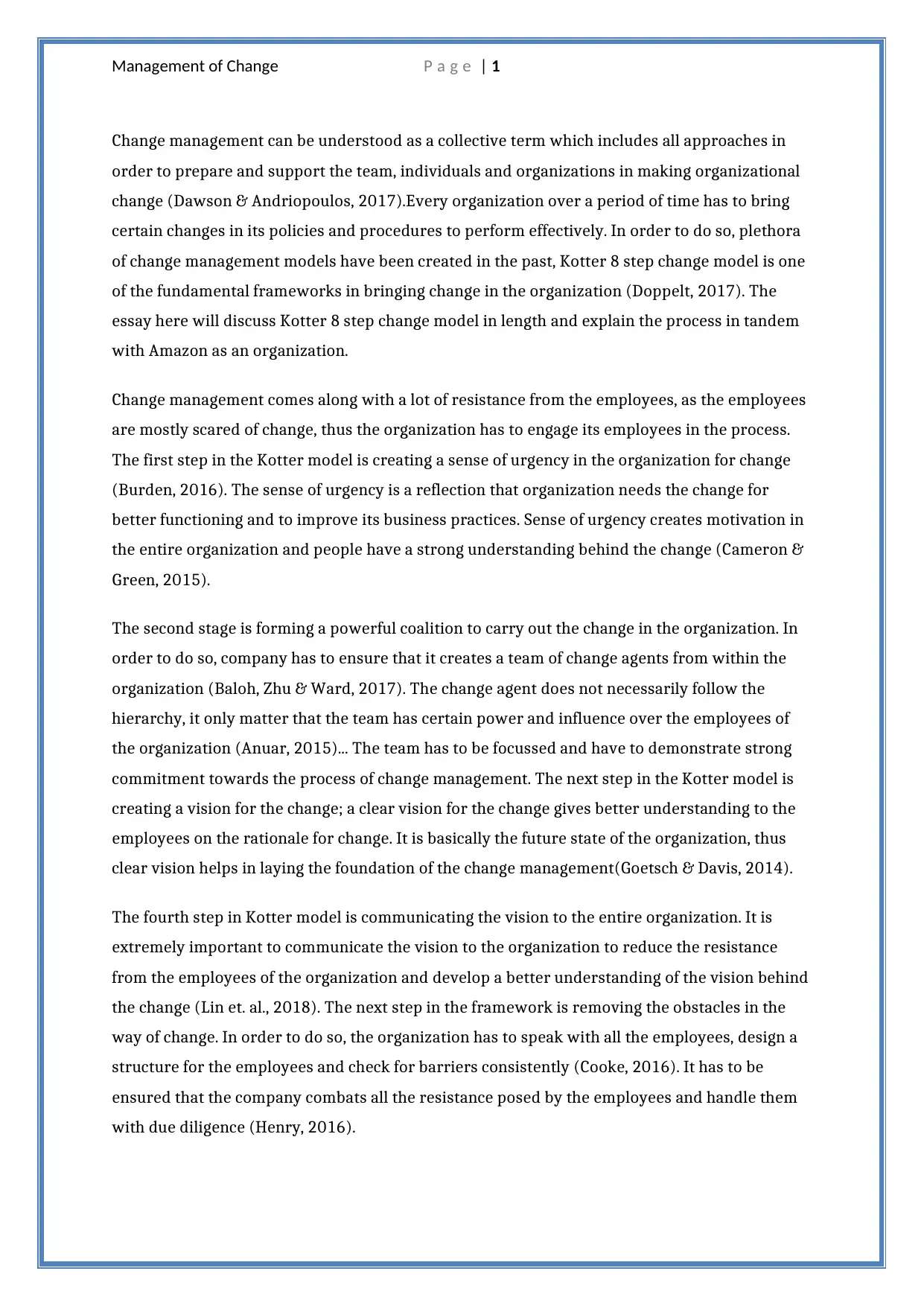
Management of Change P a g e | 1
Change management can be understood as a collective term which includes all approaches in
order to prepare and support the team, individuals and organizations in making organizational
change (Dawson & Andriopoulos, 2017).Every organization over a period of time has to bring
certain changes in its policies and procedures to perform effectively. In order to do so, plethora
of change management models have been created in the past, Kotter 8 step change model is one
of the fundamental frameworks in bringing change in the organization (Doppelt, 2017). The
essay here will discuss Kotter 8 step change model in length and explain the process in tandem
with Amazon as an organization.
Change management comes along with a lot of resistance from the employees, as the employees
are mostly scared of change, thus the organization has to engage its employees in the process.
The first step in the Kotter model is creating a sense of urgency in the organization for change
(Burden, 2016). The sense of urgency is a reflection that organization needs the change for
better functioning and to improve its business practices. Sense of urgency creates motivation in
the entire organization and people have a strong understanding behind the change (Cameron &
Green, 2015).
The second stage is forming a powerful coalition to carry out the change in the organization. In
order to do so, company has to ensure that it creates a team of change agents from within the
organization (Baloh, Zhu & Ward, 2017). The change agent does not necessarily follow the
hierarchy, it only matter that the team has certain power and influence over the employees of
the organization (Anuar, 2015)... The team has to be focussed and have to demonstrate strong
commitment towards the process of change management. The next step in the Kotter model is
creating a vision for the change; a clear vision for the change gives better understanding to the
employees on the rationale for change. It is basically the future state of the organization, thus
clear vision helps in laying the foundation of the change management(Goetsch & Davis, 2014).
The fourth step in Kotter model is communicating the vision to the entire organization. It is
extremely important to communicate the vision to the organization to reduce the resistance
from the employees of the organization and develop a better understanding of the vision behind
the change (Lin et. al., 2018). The next step in the framework is removing the obstacles in the
way of change. In order to do so, the organization has to speak with all the employees, design a
structure for the employees and check for barriers consistently (Cooke, 2016). It has to be
ensured that the company combats all the resistance posed by the employees and handle them
with due diligence (Henry, 2016).
Change management can be understood as a collective term which includes all approaches in
order to prepare and support the team, individuals and organizations in making organizational
change (Dawson & Andriopoulos, 2017).Every organization over a period of time has to bring
certain changes in its policies and procedures to perform effectively. In order to do so, plethora
of change management models have been created in the past, Kotter 8 step change model is one
of the fundamental frameworks in bringing change in the organization (Doppelt, 2017). The
essay here will discuss Kotter 8 step change model in length and explain the process in tandem
with Amazon as an organization.
Change management comes along with a lot of resistance from the employees, as the employees
are mostly scared of change, thus the organization has to engage its employees in the process.
The first step in the Kotter model is creating a sense of urgency in the organization for change
(Burden, 2016). The sense of urgency is a reflection that organization needs the change for
better functioning and to improve its business practices. Sense of urgency creates motivation in
the entire organization and people have a strong understanding behind the change (Cameron &
Green, 2015).
The second stage is forming a powerful coalition to carry out the change in the organization. In
order to do so, company has to ensure that it creates a team of change agents from within the
organization (Baloh, Zhu & Ward, 2017). The change agent does not necessarily follow the
hierarchy, it only matter that the team has certain power and influence over the employees of
the organization (Anuar, 2015)... The team has to be focussed and have to demonstrate strong
commitment towards the process of change management. The next step in the Kotter model is
creating a vision for the change; a clear vision for the change gives better understanding to the
employees on the rationale for change. It is basically the future state of the organization, thus
clear vision helps in laying the foundation of the change management(Goetsch & Davis, 2014).
The fourth step in Kotter model is communicating the vision to the entire organization. It is
extremely important to communicate the vision to the organization to reduce the resistance
from the employees of the organization and develop a better understanding of the vision behind
the change (Lin et. al., 2018). The next step in the framework is removing the obstacles in the
way of change. In order to do so, the organization has to speak with all the employees, design a
structure for the employees and check for barriers consistently (Cooke, 2016). It has to be
ensured that the company combats all the resistance posed by the employees and handle them
with due diligence (Henry, 2016).
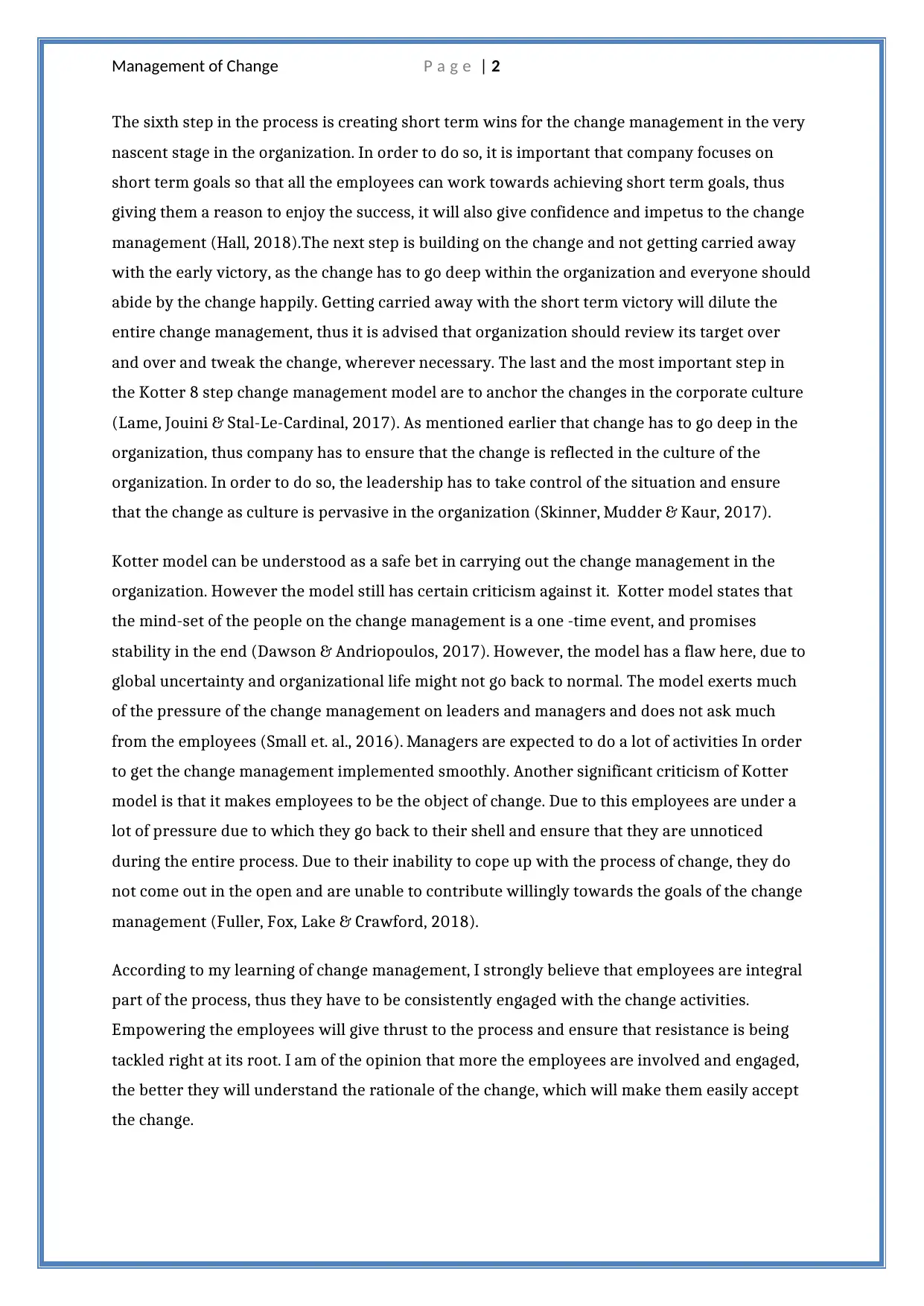
Management of Change P a g e | 2
The sixth step in the process is creating short term wins for the change management in the very
nascent stage in the organization. In order to do so, it is important that company focuses on
short term goals so that all the employees can work towards achieving short term goals, thus
giving them a reason to enjoy the success, it will also give confidence and impetus to the change
management (Hall, 2018).The next step is building on the change and not getting carried away
with the early victory, as the change has to go deep within the organization and everyone should
abide by the change happily. Getting carried away with the short term victory will dilute the
entire change management, thus it is advised that organization should review its target over
and over and tweak the change, wherever necessary. The last and the most important step in
the Kotter 8 step change management model are to anchor the changes in the corporate culture
(Lame, Jouini & Stal-Le-Cardinal, 2017). As mentioned earlier that change has to go deep in the
organization, thus company has to ensure that the change is reflected in the culture of the
organization. In order to do so, the leadership has to take control of the situation and ensure
that the change as culture is pervasive in the organization (Skinner, Mudder & Kaur, 2017).
Kotter model can be understood as a safe bet in carrying out the change management in the
organization. However the model still has certain criticism against it. Kotter model states that
the mind-set of the people on the change management is a one -time event, and promises
stability in the end (Dawson & Andriopoulos, 2017). However, the model has a flaw here, due to
global uncertainty and organizational life might not go back to normal. The model exerts much
of the pressure of the change management on leaders and managers and does not ask much
from the employees (Small et. al., 2016). Managers are expected to do a lot of activities In order
to get the change management implemented smoothly. Another significant criticism of Kotter
model is that it makes employees to be the object of change. Due to this employees are under a
lot of pressure due to which they go back to their shell and ensure that they are unnoticed
during the entire process. Due to their inability to cope up with the process of change, they do
not come out in the open and are unable to contribute willingly towards the goals of the change
management (Fuller, Fox, Lake & Crawford, 2018).
According to my learning of change management, I strongly believe that employees are integral
part of the process, thus they have to be consistently engaged with the change activities.
Empowering the employees will give thrust to the process and ensure that resistance is being
tackled right at its root. I am of the opinion that more the employees are involved and engaged,
the better they will understand the rationale of the change, which will make them easily accept
the change.
The sixth step in the process is creating short term wins for the change management in the very
nascent stage in the organization. In order to do so, it is important that company focuses on
short term goals so that all the employees can work towards achieving short term goals, thus
giving them a reason to enjoy the success, it will also give confidence and impetus to the change
management (Hall, 2018).The next step is building on the change and not getting carried away
with the early victory, as the change has to go deep within the organization and everyone should
abide by the change happily. Getting carried away with the short term victory will dilute the
entire change management, thus it is advised that organization should review its target over
and over and tweak the change, wherever necessary. The last and the most important step in
the Kotter 8 step change management model are to anchor the changes in the corporate culture
(Lame, Jouini & Stal-Le-Cardinal, 2017). As mentioned earlier that change has to go deep in the
organization, thus company has to ensure that the change is reflected in the culture of the
organization. In order to do so, the leadership has to take control of the situation and ensure
that the change as culture is pervasive in the organization (Skinner, Mudder & Kaur, 2017).
Kotter model can be understood as a safe bet in carrying out the change management in the
organization. However the model still has certain criticism against it. Kotter model states that
the mind-set of the people on the change management is a one -time event, and promises
stability in the end (Dawson & Andriopoulos, 2017). However, the model has a flaw here, due to
global uncertainty and organizational life might not go back to normal. The model exerts much
of the pressure of the change management on leaders and managers and does not ask much
from the employees (Small et. al., 2016). Managers are expected to do a lot of activities In order
to get the change management implemented smoothly. Another significant criticism of Kotter
model is that it makes employees to be the object of change. Due to this employees are under a
lot of pressure due to which they go back to their shell and ensure that they are unnoticed
during the entire process. Due to their inability to cope up with the process of change, they do
not come out in the open and are unable to contribute willingly towards the goals of the change
management (Fuller, Fox, Lake & Crawford, 2018).
According to my learning of change management, I strongly believe that employees are integral
part of the process, thus they have to be consistently engaged with the change activities.
Empowering the employees will give thrust to the process and ensure that resistance is being
tackled right at its root. I am of the opinion that more the employees are involved and engaged,
the better they will understand the rationale of the change, which will make them easily accept
the change.
⊘ This is a preview!⊘
Do you want full access?
Subscribe today to unlock all pages.

Trusted by 1+ million students worldwide
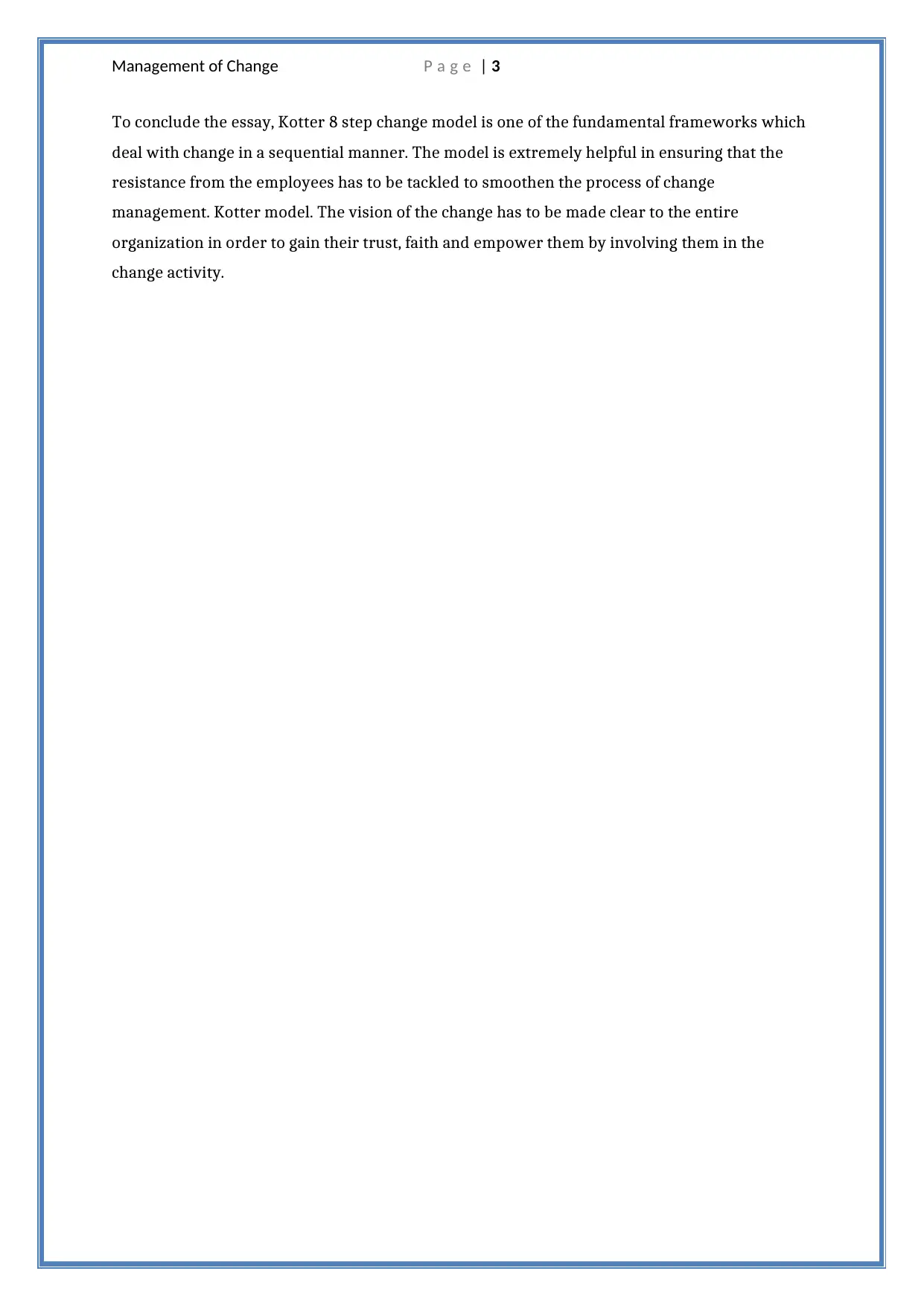
Management of Change P a g e | 3
To conclude the essay, Kotter 8 step change model is one of the fundamental frameworks which
deal with change in a sequential manner. The model is extremely helpful in ensuring that the
resistance from the employees has to be tackled to smoothen the process of change
management. Kotter model. The vision of the change has to be made clear to the entire
organization in order to gain their trust, faith and empower them by involving them in the
change activity.
To conclude the essay, Kotter 8 step change model is one of the fundamental frameworks which
deal with change in a sequential manner. The model is extremely helpful in ensuring that the
resistance from the employees has to be tackled to smoothen the process of change
management. Kotter model. The vision of the change has to be made clear to the entire
organization in order to gain their trust, faith and empower them by involving them in the
change activity.
Paraphrase This Document
Need a fresh take? Get an instant paraphrase of this document with our AI Paraphraser

Management of Change P a g e | 4
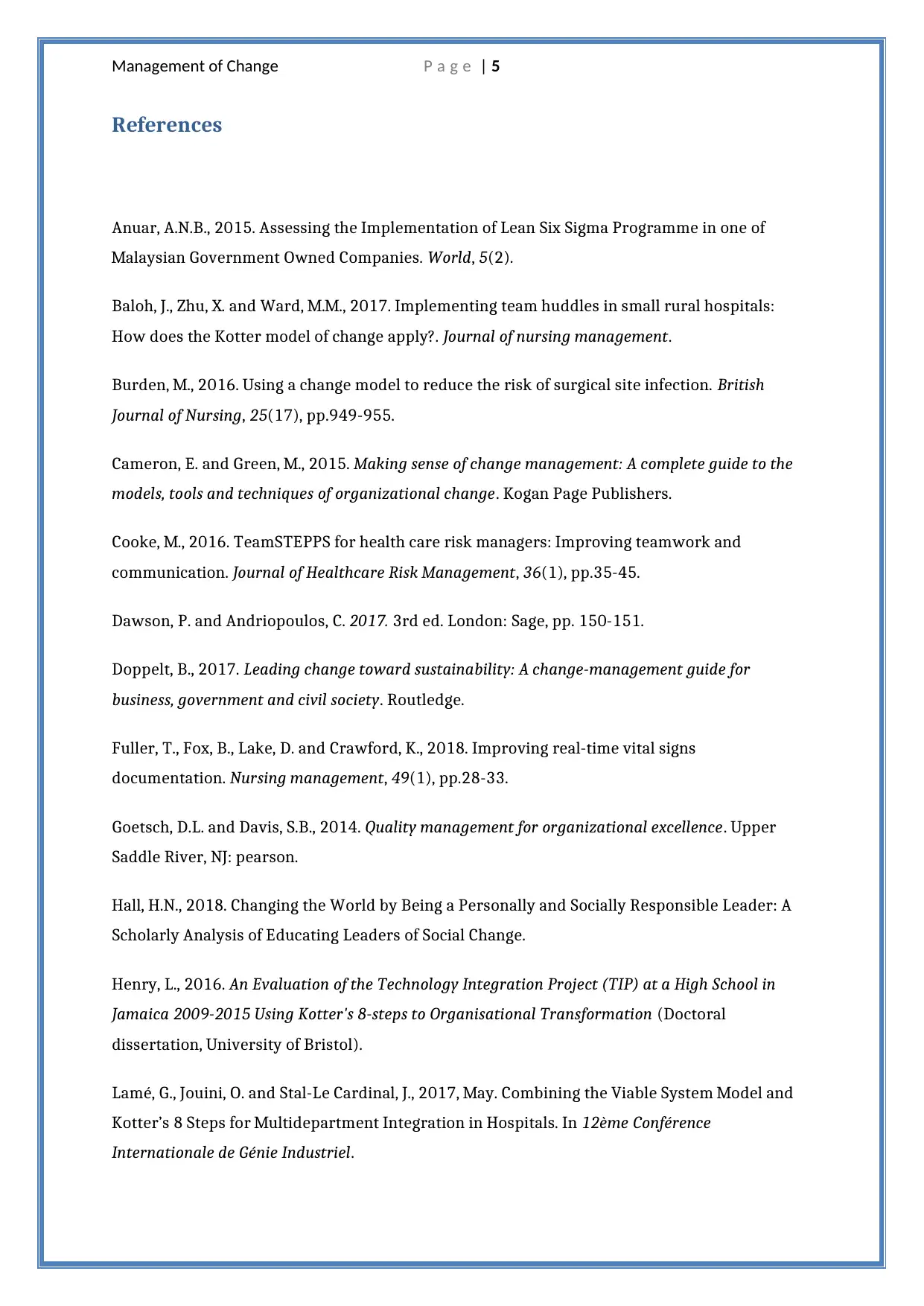
Management of Change P a g e | 5
References
Anuar, A.N.B., 2015. Assessing the Implementation of Lean Six Sigma Programme in one of
Malaysian Government Owned Companies. World, 5(2).
Baloh, J., Zhu, X. and Ward, M.M., 2017. Implementing team huddles in small rural hospitals:
How does the Kotter model of change apply?. Journal of nursing management.
Burden, M., 2016. Using a change model to reduce the risk of surgical site infection. British
Journal of Nursing, 25(17), pp.949-955.
Cameron, E. and Green, M., 2015. Making sense of change management: A complete guide to the
models, tools and techniques of organizational change. Kogan Page Publishers.
Cooke, M., 2016. TeamSTEPPS for health care risk managers: Improving teamwork and
communication. Journal of Healthcare Risk Management, 36(1), pp.35-45.
Dawson, P. and Andriopoulos, C. 2017. 3rd ed. London: Sage, pp. 150-151.
Doppelt, B., 2017. Leading change toward sustainability: A change-management guide for
business, government and civil society. Routledge.
Fuller, T., Fox, B., Lake, D. and Crawford, K., 2018. Improving real-time vital signs
documentation. Nursing management, 49(1), pp.28-33.
Goetsch, D.L. and Davis, S.B., 2014. Quality management for organizational excellence. Upper
Saddle River, NJ: pearson.
Hall, H.N., 2018. Changing the World by Being a Personally and Socially Responsible Leader: A
Scholarly Analysis of Educating Leaders of Social Change.
Henry, L., 2016. An Evaluation of the Technology Integration Project (TIP) at a High School in
Jamaica 2009-2015 Using Kotter's 8-steps to Organisational Transformation (Doctoral
dissertation, University of Bristol).
Lamé, G., Jouini, O. and Stal-Le Cardinal, J., 2017, May. Combining the Viable System Model and
Kotter’s 8 Steps for Multidepartment Integration in Hospitals. In 12ème Conférence
Internationale de Génie Industriel.
References
Anuar, A.N.B., 2015. Assessing the Implementation of Lean Six Sigma Programme in one of
Malaysian Government Owned Companies. World, 5(2).
Baloh, J., Zhu, X. and Ward, M.M., 2017. Implementing team huddles in small rural hospitals:
How does the Kotter model of change apply?. Journal of nursing management.
Burden, M., 2016. Using a change model to reduce the risk of surgical site infection. British
Journal of Nursing, 25(17), pp.949-955.
Cameron, E. and Green, M., 2015. Making sense of change management: A complete guide to the
models, tools and techniques of organizational change. Kogan Page Publishers.
Cooke, M., 2016. TeamSTEPPS for health care risk managers: Improving teamwork and
communication. Journal of Healthcare Risk Management, 36(1), pp.35-45.
Dawson, P. and Andriopoulos, C. 2017. 3rd ed. London: Sage, pp. 150-151.
Doppelt, B., 2017. Leading change toward sustainability: A change-management guide for
business, government and civil society. Routledge.
Fuller, T., Fox, B., Lake, D. and Crawford, K., 2018. Improving real-time vital signs
documentation. Nursing management, 49(1), pp.28-33.
Goetsch, D.L. and Davis, S.B., 2014. Quality management for organizational excellence. Upper
Saddle River, NJ: pearson.
Hall, H.N., 2018. Changing the World by Being a Personally and Socially Responsible Leader: A
Scholarly Analysis of Educating Leaders of Social Change.
Henry, L., 2016. An Evaluation of the Technology Integration Project (TIP) at a High School in
Jamaica 2009-2015 Using Kotter's 8-steps to Organisational Transformation (Doctoral
dissertation, University of Bristol).
Lamé, G., Jouini, O. and Stal-Le Cardinal, J., 2017, May. Combining the Viable System Model and
Kotter’s 8 Steps for Multidepartment Integration in Hospitals. In 12ème Conférence
Internationale de Génie Industriel.
⊘ This is a preview!⊘
Do you want full access?
Subscribe today to unlock all pages.

Trusted by 1+ million students worldwide
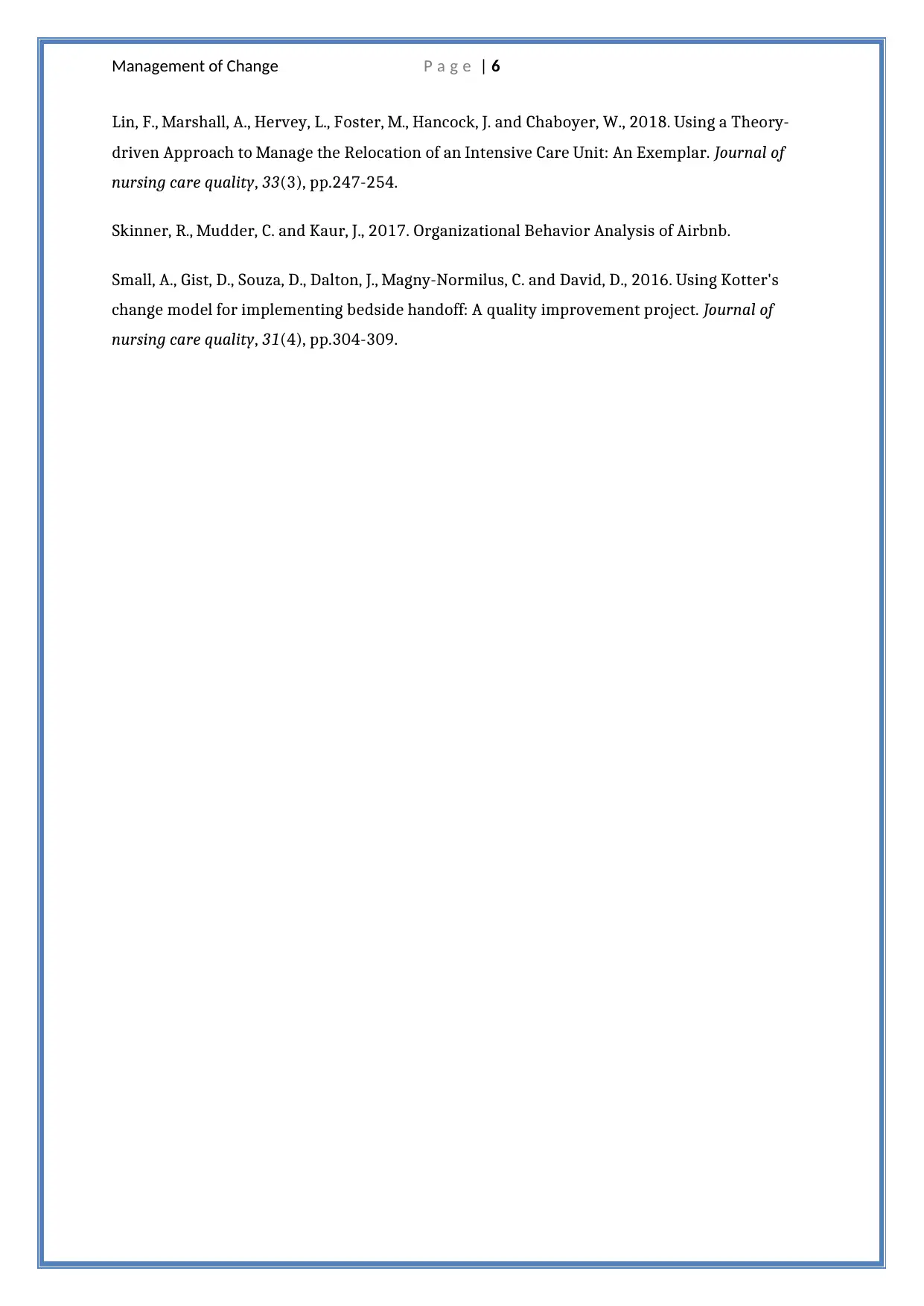
Management of Change P a g e | 6
Lin, F., Marshall, A., Hervey, L., Foster, M., Hancock, J. and Chaboyer, W., 2018. Using a Theory-
driven Approach to Manage the Relocation of an Intensive Care Unit: An Exemplar. Journal of
nursing care quality, 33(3), pp.247-254.
Skinner, R., Mudder, C. and Kaur, J., 2017. Organizational Behavior Analysis of Airbnb.
Small, A., Gist, D., Souza, D., Dalton, J., Magny-Normilus, C. and David, D., 2016. Using Kotter's
change model for implementing bedside handoff: A quality improvement project. Journal of
nursing care quality, 31(4), pp.304-309.
Lin, F., Marshall, A., Hervey, L., Foster, M., Hancock, J. and Chaboyer, W., 2018. Using a Theory-
driven Approach to Manage the Relocation of an Intensive Care Unit: An Exemplar. Journal of
nursing care quality, 33(3), pp.247-254.
Skinner, R., Mudder, C. and Kaur, J., 2017. Organizational Behavior Analysis of Airbnb.
Small, A., Gist, D., Souza, D., Dalton, J., Magny-Normilus, C. and David, D., 2016. Using Kotter's
change model for implementing bedside handoff: A quality improvement project. Journal of
nursing care quality, 31(4), pp.304-309.
1 out of 7
Related Documents
Your All-in-One AI-Powered Toolkit for Academic Success.
+13062052269
info@desklib.com
Available 24*7 on WhatsApp / Email
![[object Object]](/_next/static/media/star-bottom.7253800d.svg)
Unlock your academic potential
Copyright © 2020–2025 A2Z Services. All Rights Reserved. Developed and managed by ZUCOL.





